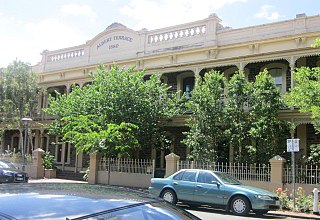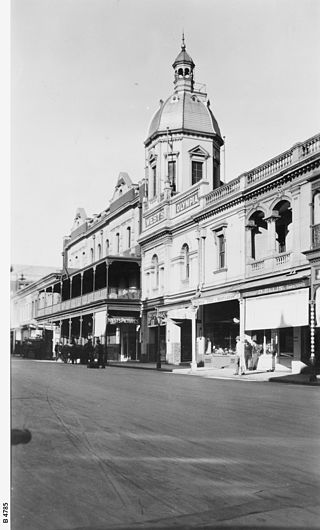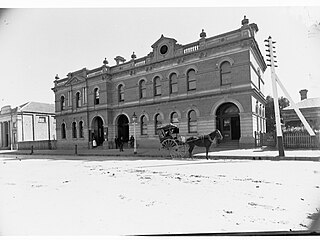Related Research Articles

Adobe is a building material made from earth and organic materials. Adobe is Spanish for mudbrick. In some English-speaking regions of Spanish heritage, such as the Southwestern United States, the term is used to refer to any kind of earthen construction, or various architectural styles like Pueblo Revival or Territorial Revival. Most adobe buildings are similar in appearance to cob and rammed earth buildings. Adobe is among the earliest building materials, and is used throughout the world.

Adelaide is the capital city of South Australia, the state's largest city and the fifth-most populous city in Australia. "Adelaide" may refer to either Greater Adelaide or the Adelaide city centre. The demonym Adelaidean is used to denote the city and the residents of Adelaide. The Traditional Owners of the Adelaide region are the Kaurna people. The area of the city centre and surrounding Park Lands is called Tarndanya in the Kaurna language.

Masonry is the craft of building a structure with brick, stone, or similar material, including mortar plastering which are often laid in, bound and pasted together by mortar; the term masonry can also refer to the building units themselves. The common materials of masonry construction are bricks and building stone such as marble, granite, and limestone, cast stone, concrete blocks, glass blocks, and adobe. Masonry is generally a highly durable form of construction. However, the materials used, the quality of the mortar and workmanship, and the pattern in which the units are assembled can substantially affect the durability of the overall masonry construction. A person who constructs masonry is called a mason or bricklayer. These are both classified as construction trades.

A concrete block, also known as a cinder block in North American English, breeze block in British English, concrete masonry unit (CMU), or by various other terms, is a standard-size rectangular block used in building construction. The use of blockwork allows structures to be built in the traditional masonry style with layers of staggered blocks.

Wagin is a town and shire in the Wheatbelt region of Western Australia, approximately 225 km (139.81 mi) south-east of Perth on the Great Southern Highway between Narrogin and Katanning. It is also on State Route 107. The main industries are wheat and sheep farming.

Rundle Mall is a pedestrian street mall located in Adelaide, South Australia. It was opened as a pedestrian mall in September 1976 by closing the section of Rundle Street between King William Street and Pulteney Street, to vehicular traffic. The street continues as Rundle Street to the east and Hindley Street to the west.

King William Street is the part of a major arterial road that traverses the CBD and centre of Adelaide, continuing as King William Road to the north of North Terrace and south of Greenhill Road; between South Terrace and Greenhill Road it is called Peacock Road. At approximately 40 metres (130 ft) wide, King William Street is the widest main street of all the Australian State capital cities. Named after King William IV in 1837, it is historically considered one of Adelaide's high streets, for its focal point of businesses, shops and other prominent establishments. The Glenelg tram line runs along the middle of the street through the city centre.


Blakiston is a town in the Australian state of South Australia. The town is located approximately 36 kilometres (22 mi) south-east of the state capital of Adelaide, adjacent to the Princes Highway. Its postal code is 5250 – though it has no post office. Post is delivered to the neighbouring town of Littlehampton which shares the post code. The town and surrounding countryside, a mixture of pastureland and eucalypt forest, make up around 16 square kilometres. At the 2021 census, the locality of Blakiston had a population of 377 and a median age of 46.

Carrington Street is a street in the south-eastern sector of the centre of Adelaide, South Australia. It runs east–west, from East Terrace to King William Street, blocked at Hutt Street and crossing Pulteney Street at Hurtle Square. It is one of the narrow streets of the Adelaide grid, at 1 chain wide.

Adelaide Arcade is a heritage shopping arcade in the centre of Adelaide, South Australia. It is linked to, and closely associated with, Gay's Arcade.

The Adelaide Glaciarium, located at 89–91 Hindley Street in the city of Adelaide, South Australia, was the first indoor ice-skating facility built in Australia. It is also the location of the first "hockey on the ice" match in the country, which was an adaptation of roller polo for the ice using ice skates. Contemporary ice hockey was never played at this venue but this ice skating rink, the country's first, provided the "test bed" facility for its successor, the Melbourne Glaciarium, the birthplace of ice hockey in Australia.

The Jubilee Exhibition Building in Adelaide, South Australia, was built to celebrate the 50th anniversary of Queen Victoria's accession to the throne on 20 June 1837. The jubilees of her Coronation on 28 June 1838, and of the Proclamation of South Australia on 28 December 1836, were also invoked on occasion.

The Port Augusta Town Hall is a heritage-listed former town hall at 54 Commercial Road, Port Augusta. It was Port Augusta's seat of local government from 1887 to 1983.

Redruth Gaol is a historic former prison in Burra, South Australia, now operating as a museum. It was the first prison in South Australia to be built outside of the state capital, Adelaide.
The MLC Building is a landmark modernist skyscraper in the central business district of North Sydney, on a block bounded by Miller Street, Denison Street and Mount Street. Planned in 1954 and completed in 1957, the complex was designed in the modernist Post-war International style by architects, Bates, Smart & McCutcheon. Its completion marked the appearance of the first high-rise office block in North Sydney and the first use of curtain wall design. Built to provide much-needed office space for the Mutual Life & Citizens Assurance Company Limited, the building continues to be primarily-occupied by its original tenants.

North Adelaide Post Office is a heritage-listed post office at 166 Tynte Street, North Adelaide, South Australia, Australia. It was added to the Australian Commonwealth Heritage List on 8 November 2011.

Piccadilly Cinema(s), formerly Piccadilly Theatre and Forum Cinema, and also known as The Piccadilly, is a cinema located on the corner of O'Connell Street and Childers Street in North Adelaide, South Australia.
Wondergraph, Wondergraph Theatre and variations were names given first to a technology, and then to picture theatres run first by the Continental Wondergraph Company ; and then, in Adelaide, South Australia, by the Wondergraph Company (1910–1911), and then the Greater Wondergraph Company, established around 1911 and in existence until 1939.
The Odeon Star Semaphore Cinemas, usually referred to as the Odeon Star, is an independent multiplex cinema in the beachside Adelaide suburb of Semaphore, South Australia. It is the oldest purpose-built cinema in Adelaide, opened on 22 May 1920 as the Wondergraph Picture Palace.
References
- ↑ "Foundation Problems in Adelaide, S.A." Construction . New South Wales, Australia. 3 December 1947. p. 15. Retrieved 3 September 2023– via National Library of Australia.
- ↑ "Brick Veneers Solve Problem". Hills Gazette . Vol. 2, no. 78. South Australia. 11 September 1974. p. 11. Retrieved 3 September 2023– via National Library of Australia.